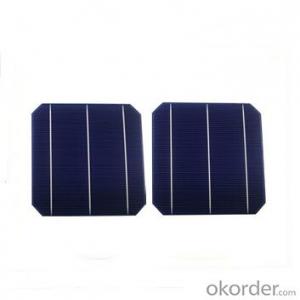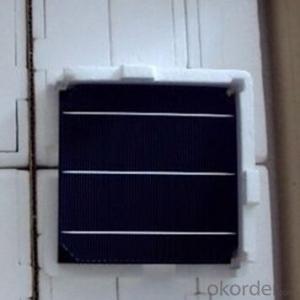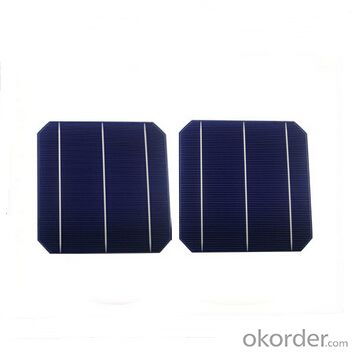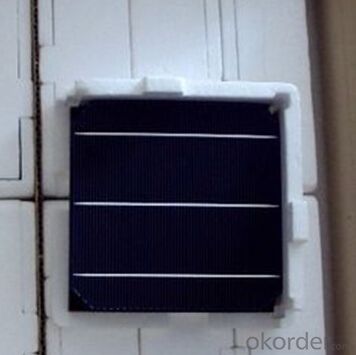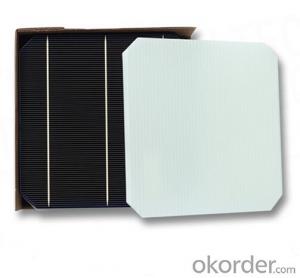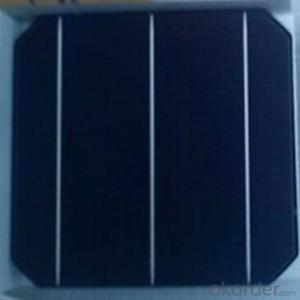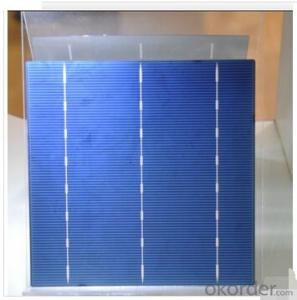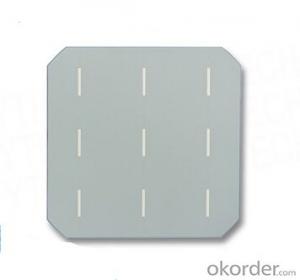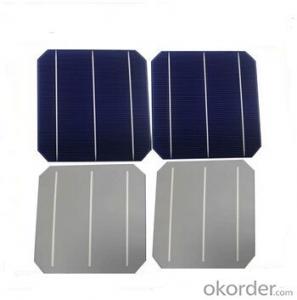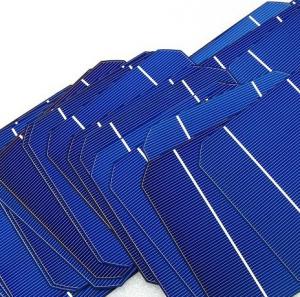Uav Solar Cells - Monocrystalline Solar Cells Series- 18.00%
- Loading Port:
- Shanghai
- Payment Terms:
- TT OR LC
- Min Order Qty:
- 1000 pc
- Supply Capability:
- 100000 pc/month
OKorder Service Pledge
OKorder Financial Service
You Might Also Like
Solar Cells:
Solar cells is made by solar wafer, it has three categories of solar cell right now, monocrystalline polycrystalline and thin film,These cells are entirely based around the concept PNjunction, which is the critical part of solar module, it is the part that can convert the light energy into electricity, the thickness is from 180um to 200um, with even busbars to conduct electricity, textured cell can decrease diffuse reflection; they are often electrically connected and encapsulated as a module. Photovoltaic modules often have a sheet of glass on the front (sun up) side, allowing light to pass while protecting semiconductor wafers from abrasion and impact due to wind-driven debris, rain, hail, etc. Solar cells are also usually connected in series in modules, creating an additive voltage. Connecting cells in parallel will yield a higher current;With high quality and stable quality. Our Cells can greatly improve the performance of Solar Modules.
Features:
High conversion efficiencies resulting in superior power output performance.
Outstanding power output even in low light or high temperature conditions
Optimized design for ease of soldering and lamination
Long-term stability,reliability and performance
Low breakage rate
Color uniformity
Specifications:
Efficiency | Power | Max Power Current | Min Power Current | Max Power Voltage | Short Circuit Current | Open Circuit Voltage |
Eff(%) | Ppm(W) | Ipm(A) | Ipm(A) | Vpm(V) | Isc(A) | Voc(V) |
19.0-19.19 | 4.54 | 8.56 | 8.44 | 0.536 | 9.05 | 0.640 |
18.80-18.99 | 4.49 | 8.53 | 8.36 | 0.534 | 9.00 | 0.639 |
18.60-18.79 | 4.44 | 8.50 | 8.32 | 0.532 | 8.97 | 0.637 |
18.40-18.59 | 4.40 | 8.46 | 8.29 | 0.530 | 8.95 | 0.636 |
18.20-18.39 | 4.35 | 8.42 | 8.23 | 0.527 | 8.93 | 0.635 |
18.00-18.19 | 4.31 | 8.34 | 8.20 | 0.523 | 8.90 | 0.634 |
Product | Monocrystalline silicon solar cell | |||||
Dimension | 156mm×156mm ±0.5mm | |||||
Diagonal | 200mm±1.0mm(Round chamfers) | |||||
Thickness(Si) | 200µm±15µm | |||||
Front | Blue silicon nitride antireflection coatings 1.4~1.6mm silver busbar ,3BB | |||||
Back | Full-surface aluminum back-surface field 2.6mm silver continuous or discrete soldering pads | |||||
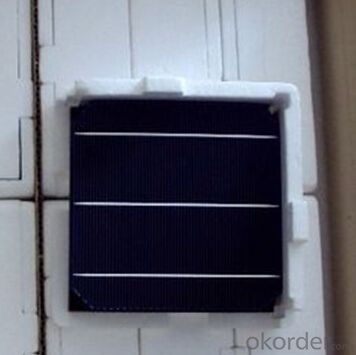
Solar Cells Advantage:
• High efficiency and stable performance in photovoltaic conversion.
• Advanced diffusion technique ensuring the homogeneity of energy conversion efficiency of the cell.
• Advanced PECVD film forming, providing a dark blue silicon nitride anti-reflection film of homogenous color and attractive appearance.
• High quality metal paste for back surface and electrode, ensuring good conductivity, high pulling strength and ease of soldering.
• High precision patterning using screen printing, ensuring accurate busbar location for ease with automatic soldering a laser cutting.
FAQ
We have organized several common questions for our clients,may help you sincerely:
①What price for each watt?
It depends on the efficiency of the solar cell, quantity, delivery date and payment terms.
②How long can we receive the product after purchase?
In the purchase of product within three working days, We will arrange the factory delivery as soon as possible. The pecific time of receiving is related to the state and position of customers.Commonly 7 to 10 working days can be served.
③Can you provide the peripheral products of the solar panels, such as the battery, controller, and inverter? If so, can you tell me how do they match each other?
Yes, we can, we have two companies for solar region, one is CNBM International, the other is CNBM engineering Co.
We can provide you not only the solar module but also the off grid solar system, we can also provide you service with on grid plant.
④What is your warranty of solar cell?
Our product can promise lower than 0.3% open box crack, we support claim after opening the box if it has crackm color difference or sth, the buyer should give pictures immediately, we can not accept the claim after the solar cell has assembled to solar panel.
• Timeliness of delivery
• ⑤How do you pack your products?
We have rich experience on how to pack the solar cell to make sure the safety on shipment, we could use wooden box or pallet as buyer's preference.
- Q: How do solar cells perform in areas with high humidity?
- Solar cells generally perform slightly less efficiently in areas with high humidity. The moisture in the air can create a barrier between the sunlight and the solar cells, reducing their ability to convert sunlight into electricity. However, advancements in solar cell technology have improved their performance in high humidity conditions, making them still viable and effective in such areas.
- Q: What is the size and weight of a typical solar cell?
- The size and weight of a typical solar cell can vary depending on its application and design. However, a common size for residential solar panels is around 65 inches by 39 inches, with a weight of approximately 40 pounds.
- Q: What is the impact of algae growth on solar cell performance?
- The impact of algae growth on solar cell performance is generally negative. Algae growth on the surface of solar cells can reduce their efficiency by blocking sunlight and causing shading. This reduces the amount of light that reaches the solar cells, thereby reducing their power output. Additionally, algae can also produce a biofilm that affects the surface properties of the solar cells, leading to further degradation in performance over time. Therefore, it is important to regularly clean and maintain solar panels to minimize the negative effects of algae growth.
- Q: Can solar cells be used to power remote weather stations?
- Yes, solar cells can be used to power remote weather stations. Solar cells can convert sunlight into electricity, providing a reliable and sustainable power source for remote locations where access to the electrical grid is limited or unavailable. This makes solar cells an ideal choice for powering weather stations in remote areas.
- Q: Can solar cells be used for powering data centers?
- Yes, solar cells can be used for powering data centers. Solar energy can be harnessed and converted into electricity through solar cells, which can then be used to power the energy-intensive operations of data centers. This renewable energy source can help reduce the environmental impact of data centers by decreasing their reliance on fossil fuels and mitigating carbon emissions. However, the feasibility of using solar cells for data centers depends on factors such as the availability of sunlight, the size of the data center, and the energy requirements of the facility.
- Q: Can solar cells be used in off-grid systems?
- Yes, solar cells can be used in off-grid systems. Off-grid systems typically rely on renewable energy sources, and solar cells are an ideal choice for generating electricity in such systems. Solar cells convert sunlight into electricity, which can be stored in batteries for use when the sun is not shining. This allows off-grid systems to power various appliances and devices without the need for a connection to the traditional power grid.
- Q: Do you believe you can make a solar cell by using kitchenware?
- You must be joking.
- Q: Can solar cells be used to power parking meters?
- Yes, solar cells can be used to power parking meters. Solar cells convert sunlight into electricity, which can be used to power various devices including parking meters. This helps reduce the dependence on traditional energy sources and promotes sustainability.
- Q: Can solar cells be used in underwater vehicles or submarines?
- Yes, solar cells can be used in underwater vehicles or submarines. However, due to the limited availability of sunlight underwater, the efficiency of solar cells in generating power is significantly reduced. Therefore, solar cells are often used as a supplementary power source in combination with other power systems such as batteries or fuel cells in underwater vehicles or submarines.
- Q: Can solar cells be used in remote communication systems?
- Yes, solar cells can be used in remote communication systems. Solar cells are capable of converting sunlight into electrical energy, which can be used to power various devices and systems, including communication systems. This is particularly advantageous in remote areas where access to traditional power sources may be limited or non-existent. Solar-powered communication systems have been successfully deployed in remote locations, providing reliable and sustainable connectivity.
Send your message to us
Uav Solar Cells - Monocrystalline Solar Cells Series- 18.00%
- Loading Port:
- Shanghai
- Payment Terms:
- TT OR LC
- Min Order Qty:
- 1000 pc
- Supply Capability:
- 100000 pc/month
OKorder Service Pledge
OKorder Financial Service
Similar products
Hot products
Hot Searches
Related keywords
